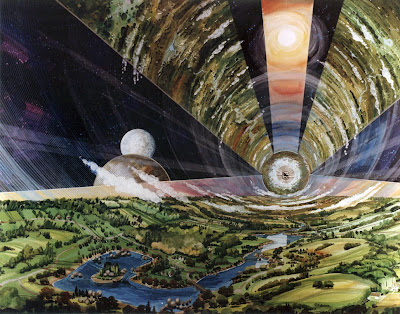
Okay, maybe I have time for one more post. Check out this NASA-commissioned artwork, recently posted over at BoingBoing. Unfortunately, I forget about BoingBoing.net all too often - because I'm very, very interested in a decent amount of what they dig up.
Here's the gallery post at BoingBoing, and the source page at NASA.

Fine. So, that explains "NASA" and "space colony" - but what of RAMA? Well, these pictures reminded me of the Rama series of sci-fi books by Arthur C. Clarke. Rama was a mysterious object entering our solar system, which turned out to be a cylindrical alien space colony, much like those pictured above. In fact, the Wikipedia page for the first book, Rendezvous with Rama (1973), even contains the first painting above.
Much like Clarke's fiction initially proposed the whole idea of geosynchronous communication satellites (in 1945!!! or at least 1956)... Rama included some bold ideas, later implemented by reality:
Clarke invented the fictional space study program which detects Rama, Project Spaceguard, as a method of identifying near-Earth objects on Earth-impact trajectories... However, a real Spaceguard project was initiated some years later, named after Clarke's fictional device. After interest in the dangers of asteroid strikes was heightened by a series of Hollywood disaster films, the United States Congress gave NASA authorization and funding to support Spaceguard.

Speaking of Arthur C. Clarke, BoingBoing also recently pointed out this very nice gallery of 2001: A Space Odyssey (1968) stills! Which was based on a Clarke short story, with screenplay co-written by him, and then novelized and sequelized again by him. It's a pretty good movie...


No comments:
Post a Comment